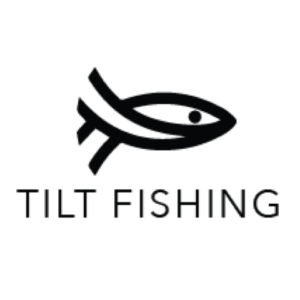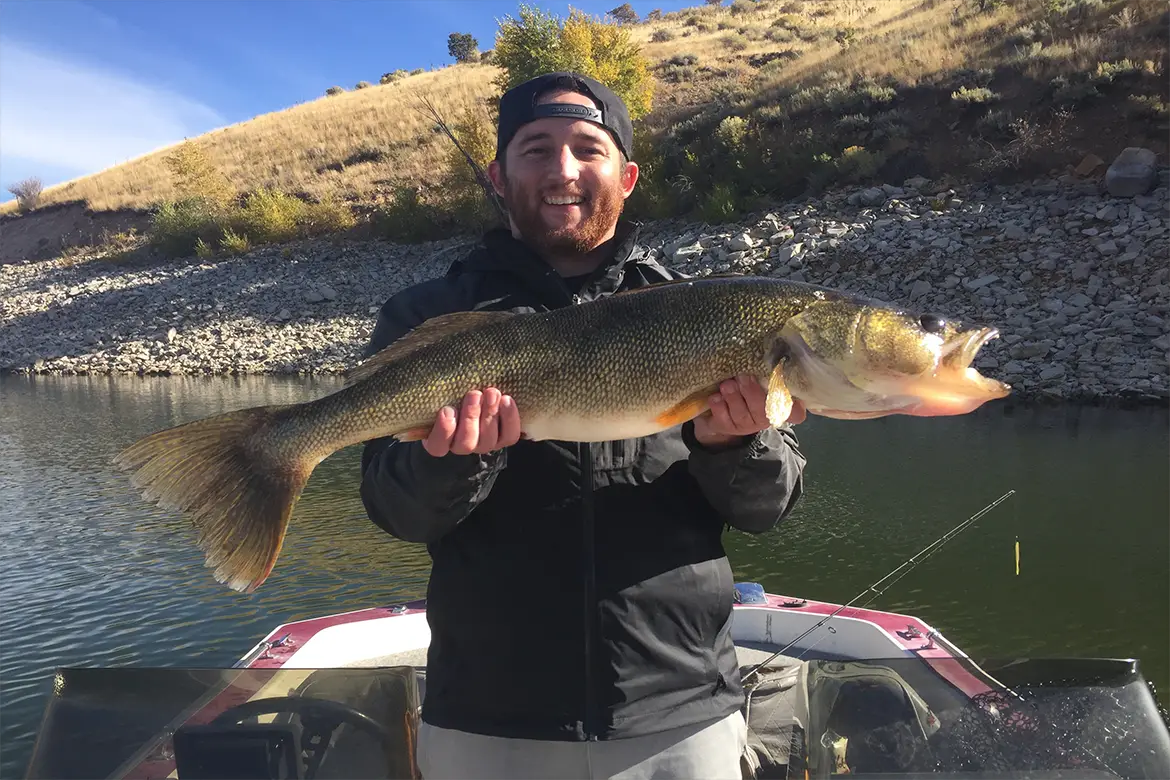Utah is home to some great walleye fishing, but they can be difficult to catch at times unless you know what you are doing. In this article we break down everything you need to know about catching walleye in Utah. This is a perfect article if you are a beginner and is also a great refresher for more experienced walleye anglers.
Basic walleye biology
Understanding the basic biology of the fish you are targeting is key in becoming a successful angler. If you can understand their biology you will be able to predict their behavior and in turn catch more fish consistently. Here are some things to keep in mind as you are walleye fishing.
- Walleye are members of the perch family
- Average life span of 10-25 years
- Are always on the bottom
- Not native to Utah, introduced in the 1900’s; can live past 25 years
- Utah State record for walleye is 16 pounds 9 ounces caught in the Provo River
Walleye feeding behavior
Walleye Less than 10 inches
- Eat 70% insect/plankton
- Eat 30% fish
Walleye 10-15 inches
- Eat 45% insect/plankton
- Eat 55% fish
Walleye Larger than 16 inches
- Eat 30% insect/plankton
- 70% fish
As you can see from the information above you can see as walleye grow bigger their diet consist of more fish than anything else. This is something to keep in mind when you are targeting bigger walleye. Fish imitating lures may be your best bet to land a monster.
Walleye fishing reputation
- Typically, a very light bite
- Extremely good eye sight and excellent vision in low-light conditions
- Warm water = Active Walleye
- Peek feeding temperature is 70-73 degrees F
- Great tasting fresh water fish
- Stop feeding when water temperature gets over 82 degrees
- Like slow moving baits
When are walleye most active?
The water temperature is one of the biggest contributing factors in walleye’s feeding behavior. As show in the graph below. Walleye will become more active feeders as the water temperature rises. Walleye will reach a maximum consumption rate (when they eat the most) when the water temperature reaches 72 degrees. Once the water temperature reaches over 72 degrees is when you will see a significant drop off in how much food walleyes will consume. When the water temperature hits 82 degrees the walleye tend to shut off and can be difficult to catch.
When do walleye spawn in Utah
The walleye spawning season in Utah often varies by the reservoir. Utah walleye will start spawning when the water temperature reaches in the 43-50-degree range. This typically occurs in March to early April in Utah.
Although walleye can be found at shallower depths during the spawn they can often be difficult to catch at times. However, post spawn the walleye become hungry making them easier to catch.
Spawning areas
- Rocky gravel areas in rivers and shallows
- Areas that have current
Bottom Line: Walleye tend to be tougher to catch during the spawn will become hungry feeders after the spawn is over.
Note: Please make sure to follow current Utah walleye fishing regulations. (https://wildlife.utah.gov/utah-fishing-guidebook.html)
Where to fish for walleye in Utah
- Starvation is known as a premier walleye fishery and some may argue the best place to target walleye in Utah.
- Starvation Reservoir
- Willard Bay Reservoir
- Deer Creek Reservoir
- Utah Lake State Park
- Provo River
- Utah Lake
- Red Fleet Reservoir
- Big Sand Wash Reservoir
- Echo Reservoir
- Yuba Reservoir
- Lake Powell
Areas to target
Many anglers think walleye can only be found in deeper water, but this isn’t always the case. Walleye can be caught anywhere from 5 inches to 60 plus feet deep. The sweet spot seems to be in that 5 inches to 30 ft. deep. But one thing is certain, walleye will almost always be found at or near the bottom unless they are chasing bait fish.
In general, the key to finding and catching walleye is first figuring out where the bait fish are. If you can find the bait fish, you will find the walleye.
But there are also some key places where walleye typically like to hang out.
Try fishing these areas:
- Deep cuts connecting main river channels to backwater lakes and sloughs
- Rocky or gravelly points
- Flats with slow current near river channels
- Main lake points
- Rip riprap banks
- Wing dams with moderate current
- Current-brushed riprap banks
Rod and Reel Setup
Making sure you have the right rod and reel combination can be the difference in catching and not catching fish. The type and action of your rod and reel will be dependent on the type of bait and lures you plan on using. The four main methods to catching walleye are trolling, spinning, jigging
Here is a basic rod and reel guide that is technique specific:
Trolling
- Height: 7’10” up to 10’ (8’6” is the perfect overall general purpose trolling rod length)
- Power: Medium to medium heavy
- Action: Moderate action
Spinning
- Height: Between 5’9‚” and 6′ long
- Power: Medium light to medium
- Action: Fast to extra-fast
Jigging
- Height: Between 5’9‚” and 6′ long
- Power: Medium light to medium
- Action: Fast to extra-fast
Rigging Rods (Live Bait)
- Height: Between 7’ to 7’6” long
- Power: Light, medium-light, to medium
- Action: Moderate to fast action
For information about selecting the right walleye fishing rod, be sure to check out this article: Best Walleye Jigging Rod by Outdoorbase.com
Line
Fishing the right line is super important. Your line is the direct connection between you and the fish. Fluorocarbon is a staple for most walleye anglers.
Walleye Lures and Baits
Jig Fishing for Walleye
Jig fishing is a great way to catch walleye. But making sure that you are using with the right colors and weight can give you a huge advantage. Here is what we have found to be most effective:
Weight:
- 1/8th oz to 3/8 oz
- 1/8th oz for fishing shallow of finicky fish
Jig Head Colors
- Chartreus
- Orange
- Pink
Trailers
- Curly tailed grub 3-5 inches (white and chartreus)
- night crawlers
Crankbaits
Using crankbaits to target walleye can be one of fastest ways to catch them and is also one of my favorites. Whether casting and cranking or trolling, crankbaits offer versatility that can put fish into the boat. There are a few key elements to remember to ensure success:
Depth: this is an important consideration. Most crankbaits will give you a depth guide on the package. You want to make sure your bait reaches and stay in the right water column and this may vary by the fish’s behavior. In general walleye will be at or near the bottom so it’s important that you use a crankbait that can reach them.
Action/wobble: as a good rule of thumb the more aggressive the fish is the more action or wobble you want to have in your bait. In most baits the wider the bait is the more wobble it will have.
Color or Pattern: as they say in the fishing world match the hatch. Wherever you are fishing try and replicate what the walleye will be eating.
Sound: this is also important to keep in mind. In general, louder sounding crankbaits work well in murkier water or when the fish are more aggressive. In clear water or when the fish are finicky, silent baits tend to excel.
Profile/Size: much like choosing a color the profile of your bait should also match the walleyes forage.
There are literally thousands of crankbaits to choose from, but all are not equal. Here are some crankbaits that have been proven in Utah:
Walleye Crankbaits
Rapala X-Rap 8 (green and pink)
Swimbaits
Jig Head
- 1/4 oz to 3/16 oz will work in most situations
Regardless of the water you are fishing you can’t go wrong with matching the hatch. This includes both color and size. This is especially true for swimbaits. Try matching the hatch with your swimbaits.
Size: 3-5 inches
Tip: Try tipping the end of your swimbait hook with a night crawler your spray some scent on it.
Bait
Using live bait can be a great way to catch walleye all-year-round in Utah. Night crawlers and leaches are the most common live bait used to for walleye in Utah and both can be super effective. Typically, most anglers will stick with night crawlers because leaches are a little tougher to get.
- Night crawlers
- Leaches
Tips: Try rigging your jigs with half of a night crawler and fish it like you would a normal jig (slow rolling it as the bait ticks the bottom). This can be a great technique, that can help you catch more fish.
Scents
Adding scents can be hit or miss at times and this is no different when fishing for walleye. But sometimes it can definitely be the deal. Popular scents for walleye are craw and shad scents. Anglers will use these attractants on both live and artificial baits.
Walleye fishing tips
- Make sure your bait always has contact with the bottom
- Walleye typically like slow moving baits
- Fish early mornings and evenings or late at night
- Try dead sticking if things get tough
- Be patient and persistent
- Try using scent
Other walleye resources to check out
- Rocky Mountain Anglers of Utah Club http://www.utahrockymountainanglers.com
- Utah Walleye Fishing Seminar https://www.youtube.com/watch?v=nKenhVfeJYI&t=2769s
- Utah Walleye Fishing Seminar 2016: https://www.youtube.com/watch?v=wy9sEBd7kE4
- Walleye Tips at Deer Creek: https://www.youtube.com/watch?v=Zve6CfTOrk8
Hopefully with these walleye fishing tips you can feel more confident in your search for landing a big walleye, and can put more fish in the boat season. So get rigged up, and go head out to the water.
Tight Lines!

